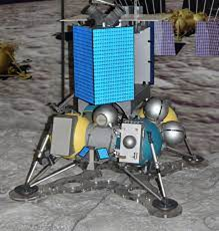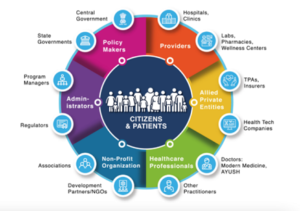Daily News Analysis.
Luna-25 Spacecraft : Russia (GS-2)
News: With the launch of its Luna-25 spacecraft, Russia will achieve a significant advancement in lunar exploration.
This project reflects both a strategic contest with India to reach the south pole of the moon and a revival of space exploration. The quest is motivated by the tantalizing prospect of finding water at the south pole of the moon.
The Chandrayaan-3 lunar lander from India and the Luna-25 spacecraft from Russia are engaged in an exciting race to the moon’s south pole. Both countries want to investigate if the moon’s south pole could be a viable source of water, which could have significant effects on the long-term existence of humans in space.
Huge ice deposits in the moon’s south pole hold the promise of being used as a resource to sustain human activity on the lunar surface. The existence of ice creates opportunities for the extraction of fuel, oxygen, and even drinking water, all of which are essential for the maintenance of upcoming human spaceflight.
ISRO: The space agency for India is called the Indian Space Research Organization (ISRO). The organization works in science, engineering, and technology to help India and humanity benefit from space. The Department of Space (DOS) of the Indian government includes ISRO as a key component. The department primarily uses different ISRO Centers or Units to carry out the Indian Space Program.
The Indian National Committee for Space Research (INCOSPAR), which was founded by the Indian government in 1962 as Dr. VikramA Sarabhai’s idea, was the predecessor to ISRO. On August 15, 1969, ISRO was established, replacing INCOSPAR with an expanded mandate to utilize space technology. In 1972, DOS was established, and ISRO was included to DOS.
The development and use of space technology for diverse national needs is ISRO/DOS’s main goal. Major space systems for communication, television broadcasting, and meteorological services, resource monitoring and management, and space-based navigation services have been built by ISRO to achieve this goal. To place the satellites in the necessary orbits, ISRO has created the PSLV and GSLV satellite launch vehicles.
Deepor Beel : Anthropogenic Threat
News: Despite being protected, Deepor Beel, a significant wetland near Guwahati, Assam, nonetheless suffers anthropogenic concerns. Indigenous names like “beel” denote ties to culture and the environment, with local economies dependent on the wetland’s supplies.
In an effort to sustainably cohabit with the marsh, local women have started businesses that turn water hyacinths into goods, creating jobs and enhancing the ecosystem.
Similar to this, “Kumbhi Kagaz” creates biodegradable paper from water hyacinths, improving the state of the wetland and promoting alternate means of subsistence.
The illustration can be used to demonstrate how local knowledge and people can be included in long-term conservation initiatives.
About Deepor Beel:
In addition to being one of the largest freshwater lakes in the area and the only Ramsar site in Assam, Deepor Beel is located to the southwest of Guwahati. It was previously a Brahmaputra River water channel and is now recognized by Birdlife International as an Important Bird Area.
Digital India RISC-V (DIR-V) Program
News: The Digital India RISC-V (DIR-V) Symposium was hosted by IIT Madras in Chennai, and the Union Minister of Electronics & IT spoke there.
The government’s goal for DIR-V, which currently intends to create a strong ecosystem for RISC-V through efficient public-private partnerships and collaborations with top academic institutions, was highlighted during the one-day symposium, which was organized by IIT Madras.
The goal of the forward-thinking Digital India RISC-V (DIR-V) Program is to strengthen India’s semiconductor industry. Its main objective is to support domestic innovation in the microprocessor industry, establishing the groundwork for independence.
The program’s future orientation is shaped by three fundamental principles: innovation, functionality, and performance. The program recognizes that in today’s digital environment, silicon chips are in higher demand.
DIR-V anticipates finding applications in a variety of fields, including cloud services, the Internet of Things (IoT), and sensors, as cutting-edge technologies like 5G and 6G change the digital environment.
India’s ambitions for high-performance computing are centerd on DIR-V. Public-private partnerships and collaborations with groups like the Centre for Development of Advanced Computing (C-DAC) will guarantee that DIR-V plays a key role in achieving these lofty objectives.
Digital Health Incentives Scheme:
News: Under the Ayushman Bharat Digital Mission (ABDM), the National Health Authority (NHA) has announced an extension of its Digital Health Incentives Scheme (DHIS).
The DHIS, which offers incentives of up to 4 crores of rupees, has been extended through December 31, 2023. Hospitals, diagnostic centers, and providers of digital health solutions are encouraged to adopt disruptive digitization practices under the Digital Health Incentives Scheme (DHIS).
The program’s objective is to create a healthcare ecosystem that is inclusive of digital technology and is consistent with the Ayushman Bharat Digital Mission’s overarching vision.
Eligibility:
The program is open to registered Digital Solution Companies (DSCs) and health facilities (hospitals, diagnostic labs) listed in ABDM’s Health Facility Registry (HFR). The financial incentives are determined by the quantity of digital health records produced and connected to individuals’ Ayushman Bharat Health Accounts (ABHA).
A total of 1205 health facilities, including 567 public and 638 private hospitals, clinics, and diagnostic labs, were registered under the DHIS as of June 2023. Twenty-two of the twenty-five digital solution businesses that have registered are from the private sector, illustrating a range of engagement.








